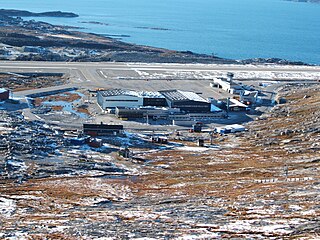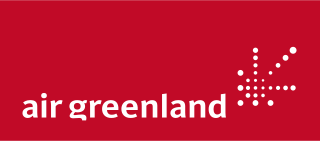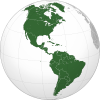Telecommunications in Greenland include radio, television, fixed and mobile telephones, and the Internet.

The transportation system in Greenland is very unusual in that Greenland has no railways, no inland waterways, and virtually no roads between towns. Historically the major means of transportation has been by boat around the coast in summer and by dog sled in winter, particularly in the north and east. Nowadays air travel, by helicopter or other aircraft, is the main way of travel.

Air Greenland A/S, also known as Greenlandair, is the flag carrier airline of Greenland, owned by the Greenlandic Government. It operates a fleet of 28 aircraft, including 2 airliners used for transatlantic and charter flights, 8 fixed-wing aircraft primarily serving the domestic network, and 18 helicopters feeding passengers from the smaller communities into the domestic airport network. Flights to heliports in the remote settlements are operated on contract with the government of Greenland.

Nuuk Airport (Greenlandic: Mittarfik Nuuk; Danish: Godthåb Lufthavn; is an airport serving Nuuk, the capital of Greenland. The airport is a technical base and focus city for Air Greenland, the flag carrier airline of Greenland, linking the capital with several towns in western and south-western part of the country, including the airline hub at Kangerlussuaq Airport. With connections to Iceland, Nuuk Airport is also one of six international airports in Greenland but serves only destinations within Greenland and Iceland. International connections are made with flights to either Keflavík International Airport in Iceland or Kangerlussuaq Airport.

Kalaallit Nunaata Radioa, also known by its abbreviation KNR, is Greenland's national public broadcasting organization.

Sisimiut, formerly known as Holsteinsborg, is the capital and largest city of the Qeqqata municipality, the second-largest city in Greenland, and the largest Arctic city in North America. It is located in central-western Greenland, on the coast of Davis Strait, approximately 320 km (200 mi) north of Nuuk.
Sarfannguit is a settlement in the Qeqqata municipality in central-western Greenland. Its population was 96 in 2020. The settlement was founded in 1843. The town is located within the Aasivissuit – Nipisat UNESCO World Heritage Site, inscribed on the World Heritage List in 2018 for its outstanding archeological sites representing the human occupation of Greenland for over 4000 years.

Sisimiut Airport is an airport located 2.2 NM northwest of Sisimiut, a town in the Qeqqata municipality in central-western Greenland. The airport has a single runway designated 13/31 which measures 799 by 30 m, built on the northern shore of Kangerluarsunnguaq Bay.

Greenland Connect is a submarine communications cable system that connects Canada, Greenland, and Iceland. The cable contains two fibre pairs specified for 128*10 Gbit/s wavelength each. Initial lit capacity is 1*10 Gbit/s for each fibre pair. Two additional 10 Gbit/s Wavelength were installed in the summer of 2010. The cable has cable landing points at:
Royal Arctic Line A/S (RAL) or Royal Arctic is a seaborne freight company in Greenland, wholly owned by the Government of Greenland. It was formed in 1993, and is headquartered in Nuuk.
Nanoq Media is a company in Greenland, who produces a television station of the same name, as well as the Nanoq FM radio station. Nanoq Media is also a service provider of broadband internet and digital TV.

Taseralik Culture Center is a cultural center in Sisimiut, a town in western Greenland, the second-largest town in the country. Located in the eastern part of Sisimiut, on the shore of the small Nalunnguarfik lake, Taseralik is the second such center in Greenland, after Katuaq in Nuuk, the capital.

Pilersuisoq is a chain of all-purpose general stores in Greenland, a major division of the state-owned KNI conglomerate. Like its parent company, it is based in Sisimiut (Holsteinsborg), the second-largest town in Greenland.

KNI A/S or Greenland Trade is a trading conglomerate in Greenland. It is the successor to the Royal Greenland Trading Department, which controlled the government of Greenland itself from 1774 to 1908 and possessed a monopoly on Greenlandic trade from 1776 to 1950. Today, the company remains a major component of the Greenlandic economy and remains fully owned by the local government. The company is based in Sisimiut (Holsteinsborg), Greenland's second-largest city, located in mid-western Greenland's Qeqqata Municipality.

Eksperimentet is a 2010 Danish drama film written and directed by Louise Friedberg, and starring Ellen Hillingsø. The film premiered on 28 August 2010 in the Katuaq Culture Centre in Nuuk, the capital of Greenland. The release date of the film in Denmark was 9 September 2010.

Pisiffik A/S is a chain of Greenlandic stores. The company is the largest privately owned commercial company in Greenland, and is a subsidiary jointly owned by NorgesGruppen, the Norwegian grocery wholesaling group, the Danish investment company KFI, and Greenland Venture, a state-owned investment firm.
The 1958 Greenlandic Football Championship was the 2nd edition of the Greenlandic Men's Football Championship. The final round was held in Qaqortoq. It was won by Grønlands Seminarius Sportklub who defeated Kissaviarsuk-33 in the final.
The 1959–60 Greenlandic Football Championship was the 3rd edition of the Greenlandic Men's Football Championship. Played on a knock-out basis, the final round was held at Gamle Sandbane in Nuuk. It was won by Nanok who defeated Kissaviarsuk-33 in the final.

Brugseni or Brugsen is a Greenlandic supermarket chain, which was founded in 1991 as a union of separate cooperatives dating back to 1963.

The COVID-19 pandemic in Greenland is part of the ongoing worldwide pandemic of coronavirus disease 2019 caused by severe acute respiratory syndrome coronavirus 2. The virus was confirmed to have spread to Greenland, an autonomous territory of the Kingdom of Denmark, in March 2020. As of 27 May 2020, there had been 13 confirmed cases, but none were in need of hospitalization. Among the first 11, the last infected person had recovered on 8 April 2020, and after that, Greenland has had no known active cases. After a period of time without any new confirmed cases, one was confirmed on 24 May when a person tested positive at the entry into the territory, and another was confirmed at entry on 27 May 2020.

















